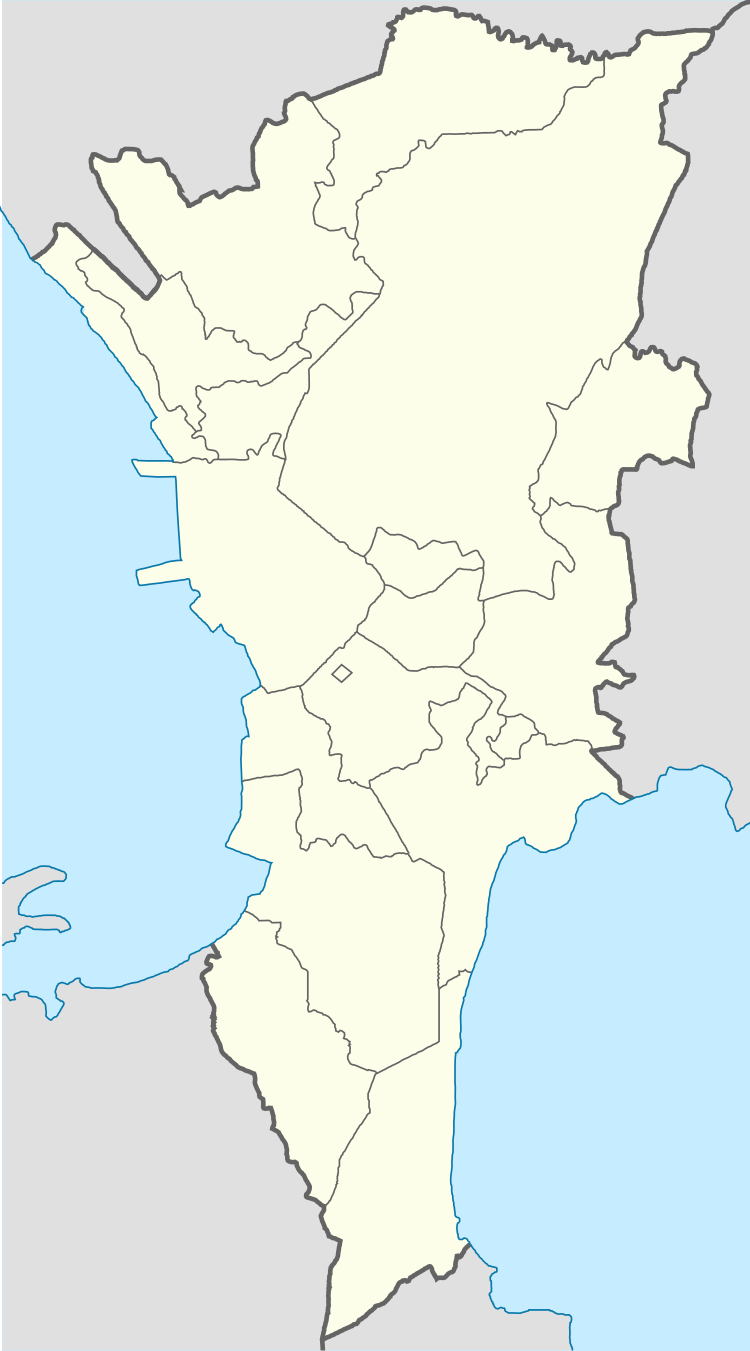Fort Bonifacio (barangay)
Fort Bonifacio is one of the 28 barangays of Taguig, Metro Manila, Philippines. The financial district of Bonifacio Global City, the Fort Bonifacio military camp and the Manila American Cemetery are under the jurisdiction of the barangay.[2]
Fort Bonifacio | |
|---|---|
_(Taguig_and_Makati)(2018-04-24)_cropped.jpg)  Clockwise from top: Bonifacio Global City Skyline, Philippine Army Entrance Gate, Heroes' Cemetery | |
 Fort Bonifacio | |
| Coordinates: 14°31′51.94″N 121°2′52.25″E | |
| Country | Philippines |
| Region | National Capital Region |
| City | Taguig |
| District | 2nd Legislative district of Taguig |
| Government | |
| • Type | Barangay |
| • Barangay Captain | Jorge Daniel Bocobo |
| Area | |
| • Total | 2.4 km2 (0.9 sq mi) |
| Population (2015) | |
| • Total | 11,739[1] |
| Time zone | UTC+8 (PST) |
| Postal Code | 1630 |
| Area code(s) | 02 |
History
During the American colonial period, the US government acquired a 25.78 square kilometre property within what was then disputed area between Makati, Taguig and Pateros for military purposes. This area (TCT dated 1902) was turned into a camp then known as Fort William McKinley after the 25th US president, William McKinley. After the Philippines gained its political independence from the United States on July 4, 1946, the US bestowed to the Republic of the Philippines all rights of possession, jurisdiction, supervision and control over the Philippine territory except the use of their military bases. On May 14, 1949, Fort McKinley was turned over to the Philippine government by virtue of US Embassy Note No. 0570.[3]
Under the AFP leadership of Gen. Alfonso Arellano, Fort McKinley was made the permanent headquarters of the Philippine Army in 1957 and was subsequently renamed Fort Bonifacio,[4] after the Father of the Philippine Revolution against Spain, Andres Bonifacio, whose father, Santiago Bonifacio, was a native of Taguig (then part of the Province of Manila / Tondo).
On December 9, 1937 the Deed of Absolute sale executed by the owner, Don Anacleto Madrigal Acopiado in favor of the American Government covering the area of 100 hectares, portion of Bicutan, Taguig, annotated at the back of TCT No. 408. During the American Commonwealth, it was converted to a Military base, named Fort McKinley. It was during the presidency of the late President Ferdinand E. Marcos' administration when Fort McKinley was renamed Fort Bonifacio and transferred to Makati. Taguig got the jurisdiction over Fort Bonifacio after winning the case against Makati in filed in the Pasig Regional Trial Court in 1993. Makati appealed the ruling, but the Pasig RTC in 2011 still sided with Taguig, saying that Fort Bonifacio including the -EMBO Baranggays are all part of Taguig. Makati then asked the Court of Appeals to review the case. The Court of Appeals overturned the Pasig Regional Trial Court's decision and reverted jurisdiction of the BGC in favor of Makati. As of date, Taguig has filed a Motion of Reconsideration at the Court of Appeals seeking to revert the decision.
The newest Court of Appeals Resolution promulgated on October 03, 2017. In a 18-page resolution promulgated on March 8 penned by Associate Justice Edwin Sorongon and was concurred by Justices Ramon Cruz and Renato Franciso, the CA’s Special Former Sixth Division granted Taguig City’s motion to dismiss citing Makati’s violation of the forum shopping rule (or pursuing simultaneous remedies in two different courts) and accordingly dismissed the latter’s appeal of the earlier decision of the Pasig City Regional Trial Court (RTC) which originally ruled in favor of Taguig. [5]
The CA took notice of the Supreme Court’s decision on June 15, 2016 which found Makati guilty of “willful and deliberate forum shopping.” [6]
“However, the Supreme Court has not spoken. Ineluctably, we must adhere. The issue of whether Makati committed willful and deliberate forum shopping in these cases has been finally laid to rest no less than by the Supreme Court,” the CA said in a ruling. [7] With this development, the rightful owner of the former military reservation is Taguig City.
Geography
The Bonifacio High Street forms the physical core of the Bonifacio Global City and is essentially designed as a three-by-three matrix of high-tech offices and residential buildings, retail outlets and pedestrian-friendly roads and walkways. The grid approach ensures a city center that is easy to navigate. The 5th and 11th Avenues and 32nd and 26th Streets serve as the boundaries of the city center. The One Bonifacio High Street, Where the PSE Tower, which houses the unified trading floor of the Philippine Stock Exchange, along with the Shangri-La at the Fort, Manila is also located.
References
- Total Population by Province, City, Municipality and Barangay: as of May 1, 2010 Archived June 25, 2012, at the Wayback Machine - Philippine Statistics Authority
- "Barangay Barangay Fort Bonifacio". ILoveTaguig. April 20, 2019.
- Barangay West Rembo Profile
- http://services.ca.judiciary.gov.ph/casestatusinquiry-war/faces/jsp/view/ViewResultInformation.jsp?form1:tabSet1:tab1_submittedLink=form1:tabSet1:tab1
- https://www.chanrobles.com/cralaw/2016junedecisions.php?id=498
- https://abogado.com.ph/ca-grants-taguig-motion-to-dismiss-makati-claim-over-bgc-dispute/
